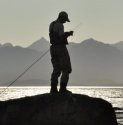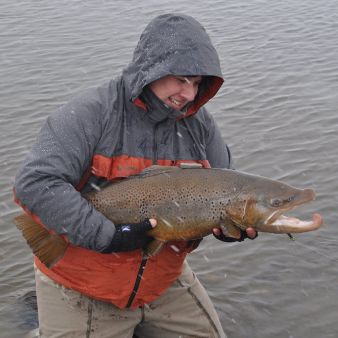Fd: How did Art and Fly Fishing get together in your life? How were your beginnings in these two different fields?
MS: Several years after I graduated from college with a degree in painting (while I was working at various non-art-related jobs,) my brother Byron began taking me fly fishing for trout. I was not very good at it, but then he introduced me to fishing for bass which was easier, and that helped me to begin to have a little success fly fishing for trout.
Fd: How did your work get so involved with stamps later on?
MS: At the same time my brother was teaching me to fish, he suggested I enter competitions to select the designs for waterfowl stamps & trout stamps, which were to be purchased along with fishing & hunting licenses. As I was not a duck hunter but was becoming a fisherman, I did not have any luck with waterfowl stamps, but did begin to win trout stamp contests. There was not much money, if any, involved, but winning a number of contests was good publicity.
Fd: Nowadays, with the #keepemwet campaign, we see many photos of fish under the water, but you’ve been painting these images long before. Why did you decide to do that?
MS: From the very beginning of fishing, I was aware that to be successful, you had to be able to imagine what was happening underwater – with the fish, with the fly or lure, with the rocks and vegetation – and this process always seemed to spark my imagination to try to paint what I envisioned happening while I was fishing. From the beginning more than thirty years ago, I was incorporating things like wading boots and anglers’ hands releasing fish.
Fd: Is there a particular message or feeling you want to convey through your works?
MS: I always hope that when I try to depict the beauty of the fish and their underwater environment, it will help inspire others to protect the resource, but I don’t know if this actually happens. Usually in my paintings I like to portray the tension in the moment such as when a fish is about to take a fly or a natural insect, though I occasionally depict hooked fish trying to escape.
Fd: Any time for fly fishing? What are your favorite species and spots?
MS: It seems that there is never enough time to fish… I enjoy fly fishing for trout and prefer fishing for bass, particularly smallmouth bass. I just returned from a trip to the Florida Keys to fly fish for tarpon, and while I was there I caught some sharks on fly. I also enjoy fishing the Atlantic coast for striped bass, bluefish, & false albacore. Every autumn my wife Roxanne & I go to North Carolina to fly fish for albies.
Fd: What advice would you give to the starting artists that want to get into the fly-fishing world?
MS: In some ways, things are harder now than when I started, because years ago there was a very strong “print” market. Nowadays, prints are more difficult to sell, but I see some younger artists employing their abilities with social media to great advantage. I guess the best advice I can give is keep growing in both your artistic abilities and in your knowledge of the sport. I have been very fortunate to have made friends of some of the luminaries of the fly-fishing world, and most have been very generous in imparting their knowledge.
Find more info about Mark's work in his website: Mark Susinno - Member of the Artists for Conservation Foundation or contact him by email: mantons@prodigy.net
MS: Several years after I graduated from college with a degree in painting (while I was working at various non-art-related jobs,) my brother Byron began taking me fly fishing for trout. I was not very good at it, but then he introduced me to fishing for bass which was easier, and that helped me to begin to have a little success fly fishing for trout.
Fd: How did your work get so involved with stamps later on?
MS: At the same time my brother was teaching me to fish, he suggested I enter competitions to select the designs for waterfowl stamps & trout stamps, which were to be purchased along with fishing & hunting licenses. As I was not a duck hunter but was becoming a fisherman, I did not have any luck with waterfowl stamps, but did begin to win trout stamp contests. There was not much money, if any, involved, but winning a number of contests was good publicity.
Fd: Nowadays, with the #keepemwet campaign, we see many photos of fish under the water, but you’ve been painting these images long before. Why did you decide to do that?
MS: From the very beginning of fishing, I was aware that to be successful, you had to be able to imagine what was happening underwater – with the fish, with the fly or lure, with the rocks and vegetation – and this process always seemed to spark my imagination to try to paint what I envisioned happening while I was fishing. From the beginning more than thirty years ago, I was incorporating things like wading boots and anglers’ hands releasing fish.
Fd: Is there a particular message or feeling you want to convey through your works?
MS: I always hope that when I try to depict the beauty of the fish and their underwater environment, it will help inspire others to protect the resource, but I don’t know if this actually happens. Usually in my paintings I like to portray the tension in the moment such as when a fish is about to take a fly or a natural insect, though I occasionally depict hooked fish trying to escape.
Fd: Any time for fly fishing? What are your favorite species and spots?
MS: It seems that there is never enough time to fish… I enjoy fly fishing for trout and prefer fishing for bass, particularly smallmouth bass. I just returned from a trip to the Florida Keys to fly fish for tarpon, and while I was there I caught some sharks on fly. I also enjoy fishing the Atlantic coast for striped bass, bluefish, & false albacore. Every autumn my wife Roxanne & I go to North Carolina to fly fish for albies.
Fd: What advice would you give to the starting artists that want to get into the fly-fishing world?
MS: In some ways, things are harder now than when I started, because years ago there was a very strong “print” market. Nowadays, prints are more difficult to sell, but I see some younger artists employing their abilities with social media to great advantage. I guess the best advice I can give is keep growing in both your artistic abilities and in your knowledge of the sport. I have been very fortunate to have made friends of some of the luminaries of the fly-fishing world, and most have been very generous in imparting their knowledge.
Find more info about Mark's work in his website: Mark Susinno - Member of the Artists for Conservation Foundation or contact him by email: mantons@prodigy.net




















